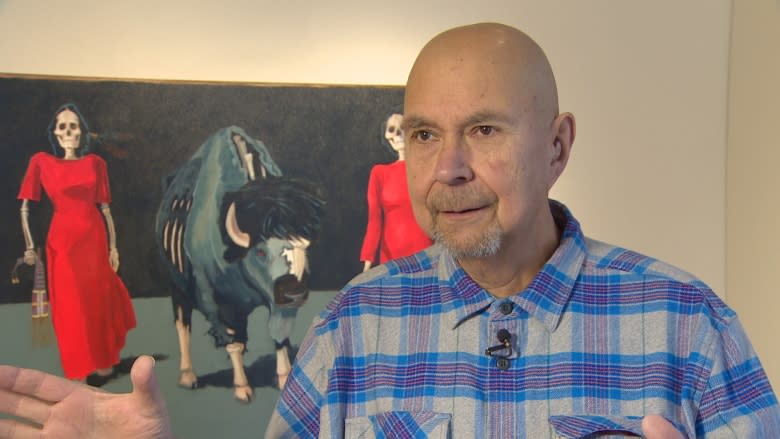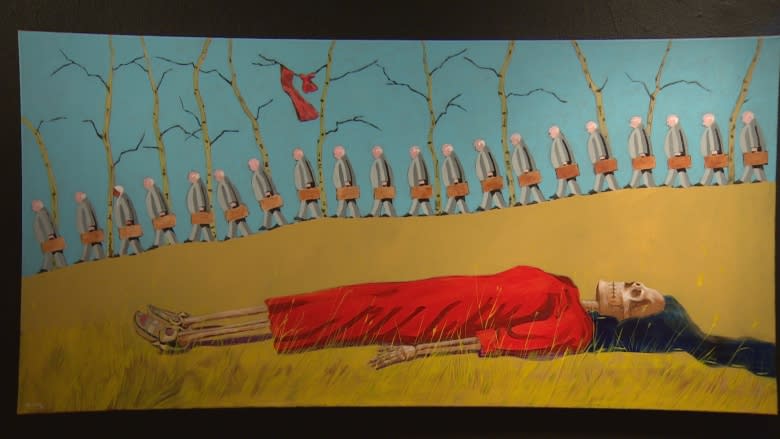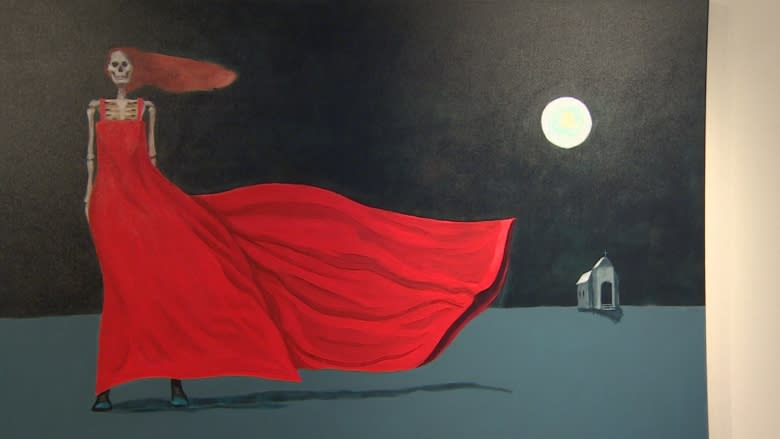'This is what we lost': Alberta artist honours missing, murdered Indigenous women and girls
Alberta artist Terry McCue was so moved the first time he heard about the REDress movement, he was inspired to come up with his own tribute to missing and murdered Indigenous women and girls.
A year and a half later, the Ojibway painter has a series of 16 works, making up the exhibit Ripples of Loss, on display at the Art Gallery of St. Albert.
"This is the most important work in my career," said McCue, 72.
The REDress Project was based on Métis artist Jaime Black's response to the issue of missing and murdered Indigenous women. Black's idea was to collect 600 red dresses and install them in public spaces across Canada, including at the University of Alberta in 2012.
Edmonton photographer Mufty Mathewson later started the REDress Photography Project. Mathewson and other photographers set out to take striking photos of red dresses in unexpected places in honour of each of Canada's missing and murdered Indigenous women and girls.
Touched by the impact of the REDress movement, McCue created paintings depicting women wearing red dresses.
But there's a sinister feel to each piece, because the women are portrayed as ghostly skeletons.
The paintings represent the overwhelming sense of loss that ripples through Indigenous families and communities.
"This is what we lost," explained McCue. "These are all about interrupted stories — stories that will never be told because someone stopped it, someone killed them, murdered them in a painful, horrible way."
Artist hopes work keeps issue on people's minds
McCue said inspiration came to him after he met Mathewson at an art show.
"I spoke with her for a few minutes and then I got up and started to go home," he said. "Walking to my car I saw the show, I saw the skeletons walking in the red dresses."
The women in the paintings are not taken from actual cases but from McCue's imagination. He chose to depict his subjects as women who were on their way to promising careers before their dreams were taken away.
When the National Inquiry into Missing and Murdered Indigenous Women and Girls held hearings in Edmonton recently, McCue attended.
"They had the hearings here for the missing and murdered women last week, so that conversation is happening. This is my part of that, this is what I can do," he said.
Nobody from McCue's family has gone missing or been murdered but after losing his sister, two brothers and both parents to drinking, loss has been a part of his life.
His show is his own creative plea to try to focus attention on the issue of missing and murdered Indigenous women.
"I have a lot of friends that I care very deeply about and I would never want this to happen to them so it has to be stopped," he said.
Originally from Curve Lake First Nation in Ontario, McCue now makes his home near Devon, Alta., where he crafted his series of paintings in his home studio.
Self-taught, he only started painting at the age of 48. He has since made a name for himself painting animals in their natural habitats.
He's never done a project like Ripples of Loss but felt a calling to take it on.
The exhibit, which opened Nov 2, is already proving to be popular for the gallery.
"People are really relating to the images and the figures in the images and the individual stories of each painting," said director and curator Jenny Willson-McGrath. "We've had people coming in and spending two hours in the gallery space."
The powerful messages in the exhibit are leading people to ask more questions and look for more information, said Willson-McGrath.
School groups in St. Albert and Edmonton have been struck by McCue's work, she said, adding art can help people understand things in ways no other medium can.
"We've had people that are deeply saddened and we've also had people who have felt ignited by the issue," she said.
Ripples of Loss is at the Art Gallery of St. Albert until Dec. 2.






